The Laboratory Washers Market is estimated to be valued at USD 1.3 billion in 2025 and is projected to reach USD 2.2 billion by 2035, registering a compound annual growth rate (CAGR) of 5.5% over the forecast period.
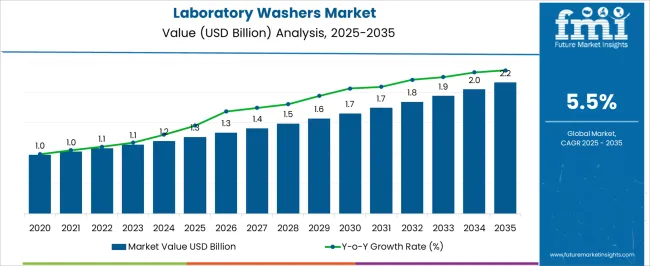
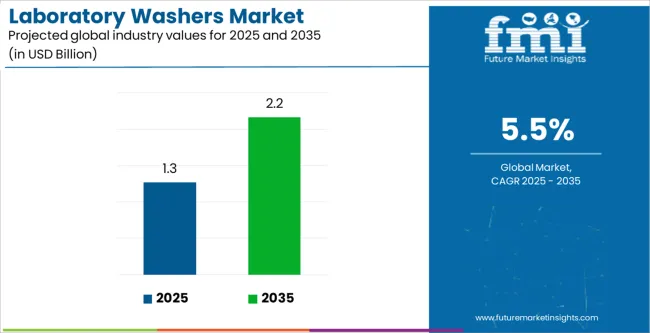
| Metric | Value |
|---|---|
| Laboratory Washers Market Estimated Value in (2025 E) | USD 1.3 billion |
| Laboratory Washers Market Forecast Value in (2035 F) | USD 2.2 billion |
| Forecast CAGR (2025 to 2035) | 5.5% |
The Laboratory Washers market is being influenced by growing investments in healthcare infrastructure, laboratory automation, and stringent hygiene protocols. The current scenario reflects an increasing demand for efficient, reliable, and easy-to-maintain washing systems that meet regulatory standards for sample preparation and contamination control. The rise in diagnostic testing, pharmaceutical research, and biotechnology applications is further contributing to the need for automated cleaning solutions.
The growing focus on laboratory safety and operational efficiency is encouraging the adoption of washers that offer precision, minimal downtime, and compatibility with various laboratory instruments. The market outlook is expected to remain positive as laboratories expand their capabilities and emphasize standardization in cleaning processes.
Additionally, the trend toward remote monitoring and IoT-enabled systems is enhancing the usability and scalability of laboratory washers As research activities intensify globally, the demand for specialized washers that can support diverse laboratory needs is likely to rise, creating new growth avenues for manufacturers that offer customizable solutions aligned with laboratory requirements.
The laboratory washers market is segmented by capacity, end use, and geographic regions. By capacity, laboratory washers market is divided into Medium Capacity, Small Capacity, and Large Capacity. In terms of end use, laboratory washers market is classified into Laboratory and Industrial. Regionally, the laboratory washers industry is classified into North America, Latin America, Western Europe, Eastern Europe, Balkan & Baltic Countries, Russia & Belarus, Central Asia, East Asia, South Asia & Pacific, and the Middle East & Africa.
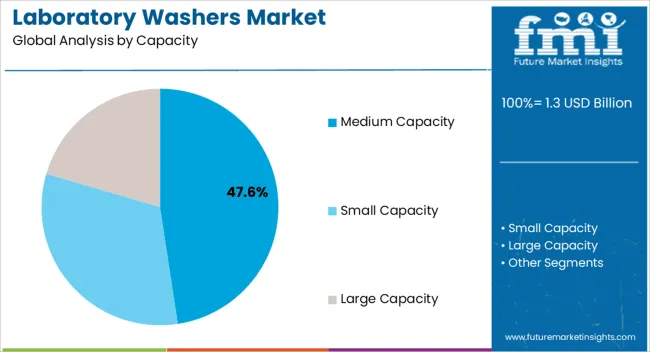
The medium capacity segment is expected to account for 47.60% of the Laboratory Washers market revenue share in 2025, making it the leading capacity type. The dominance of this segment is attributed to its balanced design that caters to a wide range of laboratory sizes and workload requirements. Medium capacity washers are being favored due to their ability to handle moderate cleaning volumes while ensuring energy efficiency and reduced water consumption.
Their compatibility with standard laboratory workflows and ability to support multiple rack configurations have further increased their adoption. Laboratories are increasingly shifting toward solutions that combine performance with cost-effectiveness, which has led to the expansion of this segment. Additionally, medium capacity washers offer flexibility in chemical compatibility and cycle programming, making them suitable for varied laboratory protocols.
The growing emphasis on laboratory automation and the need for consistent and reproducible cleaning outcomes have made medium capacity washers a preferred choice across diagnostic centers and research laboratories As laboratories seek scalable and efficient solutions, this segment is poised for sustained growth.
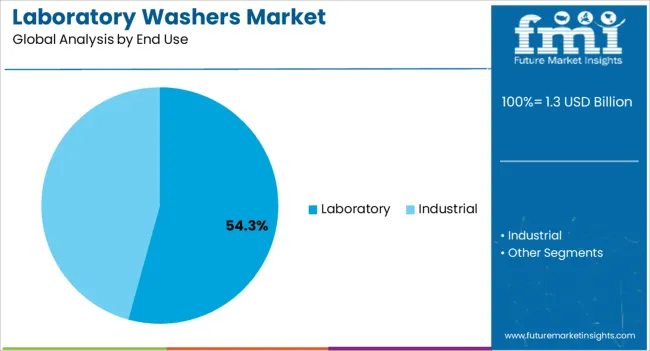
The laboratory end use segment is projected to hold 54.30% of the Laboratory Washers market revenue share in 2025, establishing it as the largest end-use segment. The growth of this segment is being driven by increasing investments in research, clinical diagnostics, and quality control environments where contamination prevention and sample integrity are critical. Laboratory washers have become indispensable tools in laboratories that require standardized cleaning processes to maintain precision and accuracy in test results.
The adoption of automated washers is being encouraged by the need to meet regulatory compliance and reduce human error during manual cleaning procedures. The rising demand for faster turnaround times and cost reduction in laboratory operations has further supported the use of advanced washers. With research institutions expanding their capabilities and diagnostic laboratories increasing testing volumes, the laboratory segment is expected to continue leading the market.
The ability of washers to support diverse workflows, along with easy integration into laboratory management systems, is enhancing their appeal, and further driving adoption across the sector This trend is anticipated to strengthen as laboratories prioritize efficiency and reliability.
The laboratory washers market is segmented by capacity, end use, and geographic regions. By capacity, laboratory washers market is divided into Medium Capacity, Small Capacity, and Large Capacity. In terms of end use, laboratory washers market is classified into Laboratory and Industrial. Regionally, the laboratory washers industry is classified into North America, Latin America, Western Europe, Eastern Europe, Balkan & Baltic Countries, Russia & Belarus, Central Asia, East Asia, South Asia & Pacific, and the Middle East & Africa.
The medium capacity segment is expected to account for 47.60% of the Laboratory Washers market revenue share in 2025, making it the leading capacity type. The dominance of this segment is attributed to its balanced design that caters to a wide range of laboratory sizes and workload requirements. Medium capacity washers are being favored due to their ability to handle moderate cleaning volumes while ensuring energy efficiency and reduced water consumption.
Their compatibility with standard laboratory workflows and ability to support multiple rack configurations have further increased their adoption. Laboratories are increasingly shifting toward solutions that combine performance with cost-effectiveness, which has led to the expansion of this segment. Additionally, medium capacity washers offer flexibility in chemical compatibility and cycle programming, making them suitable for varied laboratory protocols.
The growing emphasis on laboratory automation and the need for consistent and reproducible cleaning outcomes have made medium capacity washers a preferred choice across diagnostic centers and research laboratories As laboratories seek scalable and efficient solutions, this segment is poised for sustained growth.
The laboratory end use segment is projected to hold 54.30% of the Laboratory Washers market revenue share in 2025, establishing it as the largest end-use segment. The growth of this segment is being driven by increasing investments in research, clinical diagnostics, and quality control environments where contamination prevention and sample integrity are critical. Laboratory washers have become indispensable tools in laboratories that require standardized cleaning processes to maintain precision and accuracy in test results.
The adoption of automated washers is being encouraged by the need to meet regulatory compliance and reduce human error during manual cleaning procedures. The rising demand for faster turnaround times and cost reduction in laboratory operations has further supported the use of advanced washers. With research institutions expanding their capabilities and diagnostic laboratories increasing testing volumes, the laboratory segment is expected to continue leading the market.
The ability of washers to support diverse workflows, along with easy integration into laboratory management systems, is enhancing their appeal, and further driving adoption across the sector This trend is anticipated to strengthen as laboratories prioritize efficiency and reliability.
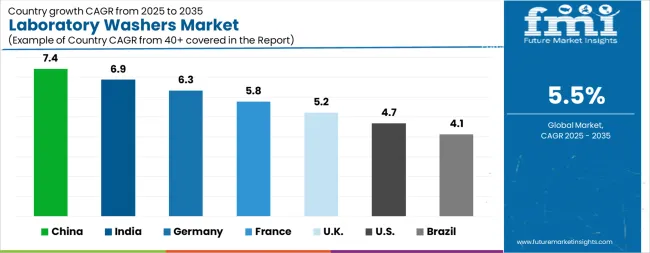
| Country | CAGR |
|---|---|
| China | 7.4% |
| India | 6.9% |
| Germany | 6.3% |
| France | 5.8% |
| UK | 5.2% |
| USA | 4.7% |
| Brazil | 4.1% |
The Laboratory Washers Market is expected to register a CAGR of 5.5% during the forecast period, exhibiting varied country level momentum. China leads with the highest CAGR of 7.4%, followed by India at 6.9%. Developed markets such as Germany, France, and the U.K. continue to expand steadily, while the U.S. is likely to grow at consistent rates. Brazil posts the lowest CAGR at 4.1%, yet still underscores a broadly positive trajectory for the global Laboratory Washers Market. In 2024, Germany held a dominant revenue in the Western Europe market and is expected to grow with a CAGR of 6.3%. The U.S. Laboratory Washers Market is estimated to be valued at USD 454.2 million in 2025 and is anticipated to reach a valuation of USD 717.3 million by 2035. Sales are projected to rise at a CAGR of 4.7% over the forecast period between 2025 and 2035. While Japan and South Korea markets are estimated to be valued at USD 65.0 million and USD 37.2 million respectively in 2025.
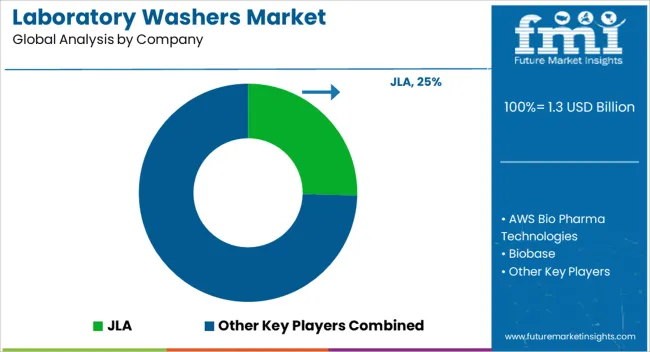
| Item | Value |
|---|---|
| Quantitative Units | USD 1.3 Billion |
| Capacity | Medium Capacity, Small Capacity, and Large Capacity |
| End Use | Laboratory and Industrial |
| Regions Covered | North America, Europe, Asia-Pacific, Latin America, Middle East & Africa |
| Country Covered | United States, Canada, Germany, France, United Kingdom, China, Japan, India, Brazil, South Africa |
| Key Companies Profiled | JLA, AWS Bio Pharma Technologies, Biobase, Comenda, DIHR, Distek, Fagor, IMA Pharma, Labconco, Miele & Cie, Scientek Technology, SMEG, and SP Scientific |
The global laboratory washers market is estimated to be valued at USD 1.3 billion in 2025.
The market size for the laboratory washers market is projected to reach USD 2.2 billion by 2035.
The laboratory washers market is expected to grow at a 5.5% CAGR between 2025 and 2035.
The key product types in laboratory washers market are medium capacity, small capacity and large capacity.
In terms of end use, laboratory segment to command 54.3% share in the laboratory washers market in 2025.






Our Research Products

The "Full Research Suite" delivers actionable market intel, deep dives on markets or technologies, so clients act faster, cut risk, and unlock growth.

The Leaderboard benchmarks and ranks top vendors, classifying them as Established Leaders, Leading Challengers, or Disruptors & Challengers.

Locates where complements amplify value and substitutes erode it, forecasting net impact by horizon

We deliver granular, decision-grade intel: market sizing, 5-year forecasts, pricing, adoption, usage, revenue, and operational KPIs—plus competitor tracking, regulation, and value chains—across 60 countries broadly.

Spot the shifts before they hit your P&L. We track inflection points, adoption curves, pricing moves, and ecosystem plays to show where demand is heading, why it is changing, and what to do next across high-growth markets and disruptive tech

Real-time reads of user behavior. We track shifting priorities, perceptions of today’s and next-gen services, and provider experience, then pace how fast tech moves from trial to adoption, blending buyer, consumer, and channel inputs with social signals (#WhySwitch, #UX).

Partner with our analyst team to build a custom report designed around your business priorities. From analysing market trends to assessing competitors or crafting bespoke datasets, we tailor insights to your needs.
Supplier Intelligence
Discovery & Profiling
Capacity & Footprint
Performance & Risk
Compliance & Governance
Commercial Readiness
Who Supplies Whom
Scorecards & Shortlists
Playbooks & Docs
Category Intelligence
Definition & Scope
Demand & Use Cases
Cost Drivers
Market Structure
Supply Chain Map
Trade & Policy
Operating Norms
Deliverables
Buyer Intelligence
Account Basics
Spend & Scope
Procurement Model
Vendor Requirements
Terms & Policies
Entry Strategy
Pain Points & Triggers
Outputs
Pricing Analysis
Benchmarks
Trends
Should-Cost
Indexation
Landed Cost
Commercial Terms
Deliverables
Brand Analysis
Positioning & Value Prop
Share & Presence
Customer Evidence
Go-to-Market
Digital & Reputation
Compliance & Trust
KPIs & Gaps
Outputs
Full Research Suite comprises of:
Market outlook & trends analysis
Interviews & case studies
Strategic recommendations
Vendor profiles & capabilities analysis
5-year forecasts
8 regions and 60+ country-level data splits
Market segment data splits
12 months of continuous data updates
DELIVERED AS:
PDF EXCEL ONLINE
Laboratory Precision Oven Market Size and Share Forecast Outlook 2025 to 2035
Laboratory Information System Market Forecast and Outlook 2025 to 2035
Laboratory Centrifuge & Accessories Market Size and Share Forecast Outlook 2025 to 2035
Laboratory Shakers Market Size and Share Forecast Outlook 2025 to 2035
Laboratory Rockers and Shakers Market Size and Share Forecast Outlook 2025 to 2035
Laboratory Filtration Devices Market Size and Share Forecast Outlook 2025 to 2035
Laboratory and Medical Scale Ozone Generator Market Size and Share Forecast Outlook 2025 to 2035
Laboratory Furnaces Market Analysis - Size, Share, and Forecast 2025 to 2035
Laboratory Supplies Market Size and Share Forecast Outlook 2025 to 2035
Laboratory Benchtop Automation Market Growth – Trends & Forecast 2025 to 2035
Laboratory Balances and Scales Market Growth - Industry Forecast 2025 to 2035
Global Laboratory Filter Paper Market Growth – Trends & Forecast 2024-2034
Laboratory Sample Container Market
Laboratory Filtration Equipment Market Growth – Trends & Forecast 2019-2027
Laboratory Glassware and Plasticware Market
Laboratory Ovens Market Analysis by Mechanical Convection and Vacuum Ovens Type through 2035
AI in Laboratory Solution Market Size and Share Forecast Outlook 2025 to 2035
Dental Laboratory Market Size and Share Forecast Outlook 2025 to 2035
Laboratory Grinders Market Size and Share Forecast Outlook 2025 to 2035
Burner Washers for Waste Gas Treatment Market Size and Share Forecast Outlook 2025 to 2035

Thank you!
You will receive an email from our Business Development Manager. Please be sure to check your SPAM/JUNK folder too.
Chat With
MaRIA